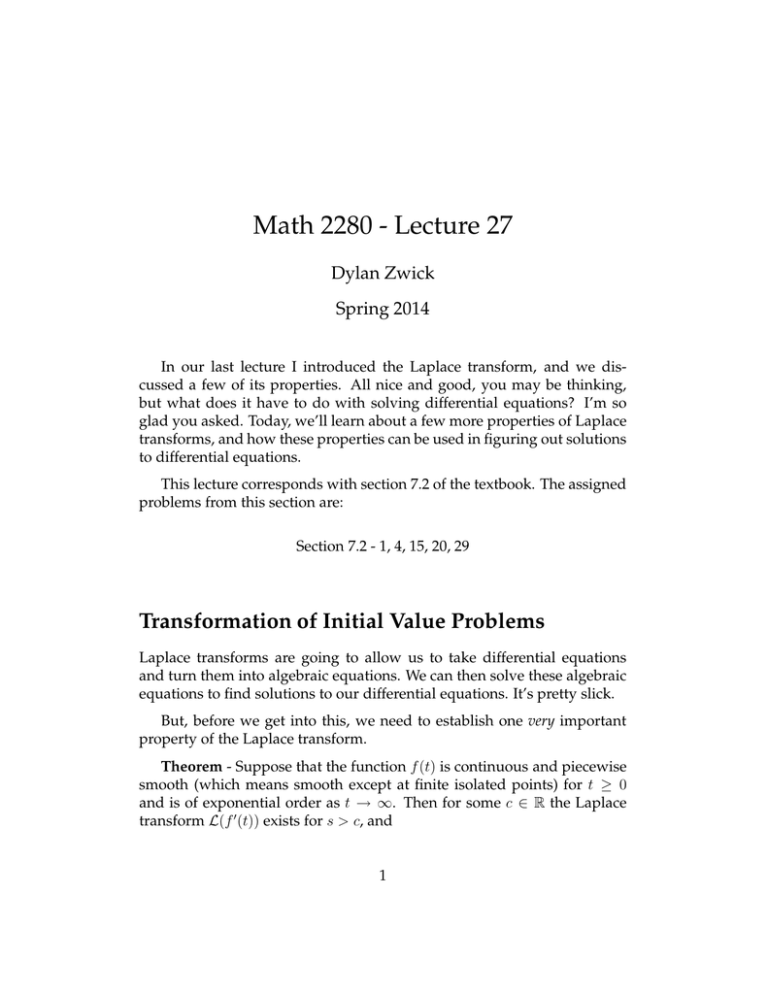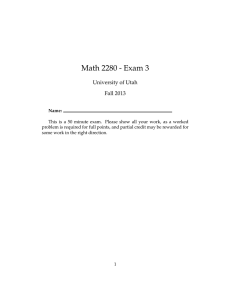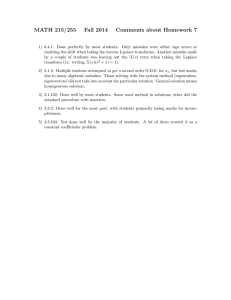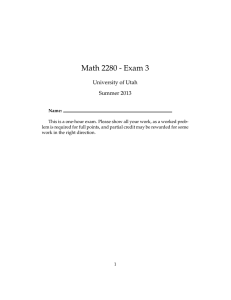Math 2280 - Lecture 27 Dylan Zwick Spring 2014
advertisement

Math 2280 - Lecture 27 Dylan Zwick Spring 2014 In our last lecture I introduced the Laplace transform, and we discussed a few of its properties. All nice and good, you may be thinking, but what does it have to do with solving differential equations? I’m so glad you asked. Today, we’ll learn about a few more properties of Laplace transforms, and how these properties can be used in figuring out solutions to differential equations. This lecture corresponds with section 7.2 of the textbook. The assigned problems from this section are: Section 7.2 - 1, 4, 15, 20, 29 Transformation of Initial Value Problems Laplace transforms are going to allow us to take differential equations and turn them into algebraic equations. We can then solve these algebraic equations to find solutions to our differential equations. It’s pretty slick. But, before we get into this, we need to establish one very important property of the Laplace transform. Theorem - Suppose that the function f (t) is continuous and piecewise smooth (which means smooth except at finite isolated points) for t ≥ 0 and is of exponential order as t → ∞. Then for some c ∈ R the Laplace transform L(f ′ (t)) exists for s > c, and 1 L(f ′(t)) = sL(f (t)) − f (0) = sF (s) − f (0), s > c. From this it follows by induction that: L(f (n) (t)) = sn F (s) − sn−1 f (0) − sn−2 f ′ (0) − · · · − sf n−2 (0) − f n−1 (0), s > c. This is huge! What it means is that not only can we take Laplace transforms of functions, we can take Laplace transforms of linear differential equations!1 Example - Use Laplace transforms to solve the initial value problem: x′′ + 9x = 0; x(0) = 3; x′ (0) = 4. 1 Great Scott! 2 Let’s see that again. Example - Find the solution to the initial value problem below using Laplace transforms: x′′ + 8x′ + 15x = 0; x(0) = 2; x′ (0) = 3 3 Now, just as with differentiation, we have a relation between the Laplace transform of a function and the Laplace transform of the integral of the function. Theorem - If f (t) is a piecewise continuous function for t ≥ 0 and satisfies the condition of exponential order, then L Z t f (τ )dτ 0 1 F (s) = L(f (t)) = s s for s > c. Equivalently, Z t F (s) −1 = f (τ )dτ . L s 0 Now, these differentiation and integration rules can be exploited to make the calculation of some Laplace transforms much easier. Example - Find L(t sin kt). 4 Notes on Homework Problems Problems 7.2.1 and 7.2.4 involve solving linear differential equation using Laplace transoforms in a manner very similar to the examples from these notes. Problem 7.2.15 is more difficult, and involves a system of two differential equations. You’ll want to first write this as a system involving the Laplace transforms, and then solve this system for each Laplace transform individually, and then take the inverse Laplace transforms. For problem 7.2.20 think partial fraction decomposition. Problem 7.2.29 is very similar to the example problem above where we derive the Laplace transform of t sin (kt). 5




